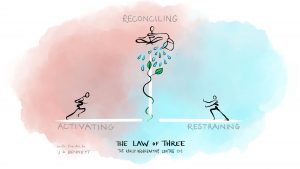I have been humbled and honoured to be asked to be part of the regenerative learning inquiry that the staff at The RSA have just embarked on. The regenerative futures team have designed an fascinating pathway over three months in this introductory period, where each monthly flow of interactions and interventions begins with a spark exploration. I was invited to host the first spark yesterday.
Andy Haldane, the CEO of The RSA and all the team there are super bright people so when it came to questions, I have to confess to feeling slightly nervous. A regenerative dialogue is about building the capacity for regenerative thinking and being, and is therefore more about inquiry than answering questions. Answering questions lends itself to the ‘expert’ model we are used to. So if I chose to answer questions, could I respond in a way that offered regenerative capability building and might happen if I chose not to answer and stayed fully in a regenerative state of being and interaction?
In the end I think I danced a bit between both. Which is totally normal in the regenerative journey. It’s really challenging to stay in a regenerative state in which you practice regenerative ways of learning all the time in the early stages of change. We fall out of it. It is something at which we get better and better over time – that’s why we call it a practice! An intentional one. I fall out all the time.
However there were a couple of explorations in which we were able to hold regenerative inquiry, so with their permission I want to share those.
Tension and Polarity
The first was a question about tension and polarity.
How do we approach a situation where two groups have fallen into determined opposition? How do we bring regeneration into that space?
Some people love frameworks, others not so much. I find them very helpful when they’re good ones. J G Bennett’s Law of Three is a good one. It goes like this. At any time there are three energies available to us. The activation energy which is starting, challenging, originating, opening energy. It’s ‘let’s do’, ‘can we’ energy in any action or conversation. Then there is resisting or restraining energy. This is ‘we can’t’, ‘we question’, ‘we oppose’ type of energy.
 When societies become polarised – as many of ours are at the moment – it’s very hard to see the third energy that is always available to us. We become stuck in our polarity and entrenched in our positions. The third energy is the energy of evolutionary potential. As is often the case when working with regenerative thinking, you need to find the right framework for sensemaking and then you have to be able to share it. Luckily as I was scrabbling around on the floor with a pen and paper, the amazing Benny produced the framework on the screen!
When societies become polarised – as many of ours are at the moment – it’s very hard to see the third energy that is always available to us. We become stuck in our polarity and entrenched in our positions. The third energy is the energy of evolutionary potential. As is often the case when working with regenerative thinking, you need to find the right framework for sensemaking and then you have to be able to share it. Luckily as I was scrabbling around on the floor with a pen and paper, the amazing Benny produced the framework on the screen!
What is the energy of evolutionary potential? Let’s take a quick diversion into living systems principles. These are principles by which life creates the conditions conducive to life to continue – and has done successfully for about 3.8 billion years. One of the most important of these is life is constantly evolving and as it does so, life always adds more complexity – or greater value – as it makes the next leap in evolution. From the first single celled organisms that appeared 3.8 billion years ago, life has evolved constantly. Multi-celled. Multi-specied. Multi-formed. As a life form, we’ve done that too. Hunter gatherers. Agriculturists. Tribalists. Scientists. Industrialists. Philanthropists. Exponentialists. All previous forms are an experiment for the next evolution. It’s a core principle and pattern of life. Once you’ve seen it you can see it everywhere you look. Think of the climate lines for example. Same pattern.

The third energy represents that potential. It represents what the current state can evolve to in the context of its particular time and place. It is not about compromise, nor is it about conflict resolution – it is about new potential ‘something’ that can be born, which, through bringing it into being, reconciles the polarity and at the same time creates the conditions conducive to life to continue in a wholly new way. And it’s usually something we have not yet imagined into being.
Let’s make it real. Real examples under discussion included the tensions that can arise between local authorities who are mandated by government to build houses, the house builders and the community in the locality that wants to protect and preserve land for nature and biodiversity. A challenge that is popping up all over the country.
The activating and restraining energies hold us stuck. We get stuck in a position, in vested interests, in our stories and a power struggle between right/wrong when we’re locked in polarities. We spend a lot of time in judgement, othering, anger, frustration etc. There’s an enormous amount of emotion, energy, tension and grief in the stuckness but forward momentum is hindered The evolutionary potential is available but it’s as if it’s invisible behind a cloud. How do you bring it into vision?
What enables two communities to move out of heat and tension – or any individual, organisation or situation – is the inner work demanded of us. If we can arrive close to a place where both parties can agree that there is a possibility of both being right and both being wrong – forward momentum becomes possible. Easy to say, very hard to do. Because there is no real right or wrong, if both are true, they cancel each other out.
To arrive even close to that place, some reflective process, conversations and powerful questions are necessary. Ideally there’s a long term commitment in organisations to a developmental path for all their people.
Questions like:
- To what extent are you invested in the wellbeing of the whole?
- What’s the story you hear yourself telling that you are wedded to and maybe even take your identity from about your position?
- What are the benefits to you of holding on to this story/position?
- What’s your attachment to it?
- What are you doing to contribute to the very thing you are complaining about?
It’s also important to allow for the dissent and disagreement to be acceptable and exist openly in the community.
- What doubts do you have?
- What forgiveness are you withholding?
- What resentment do you hold that no one knows about?
These are powerful questions that come from the work of Peter Block. His work on creating structure of belonging has had remarkable success over the years. I borrow them from him. This process and space has to be held for opposing groups by seasoned practitioners in a safe contained space and culture. Often that’s not present at the outset so it has to be gradually created.
When you have reached a point where both groups – as honestly as they can – are ready to acknowledge the both right/wrong territory, evolutionary potential becomes visible. Then it is a question of asking the right question which is a co-creative collaborative inquiry.
What is the evolution of X that is appropriate for the unique context of where we are now that creates the conditions for more life and viability?
Almost always it is something we have never imagined before. That also requires us to grow new capabilities within ourselves. In other words, the process itself also requires us to evolve too alongside the evolving X we bring into being.
In the case of local authority vs nature, that might be an inquiry question such as ‘what is the process that we need to engage in, for these circumstances of conflict between house-building and nature preservation, that allows us both to enable the conditions for life to continue – for all life – here?’ Right now the only process we have is conflict resolution and that does not necessarily create new evolutionary potential.
Let’s finish on an example I shared which hopefully most people can connect to or have ready about. The end of apartheid in South Africa.
At the time the activating energy was the demand for majority rule. The resisting energy was represented by the US, the UK, vested organisational interests who wanted to maintain apartheid, and even sometimes different local groups who has been set against each other during the colonial era. The evolutionary way forward was to create something new that everyone could focus on working towards together, which historically we describe as The Rainbow Nation. A nation where one group did not win and others did not lose (even if they thought they had) but could vest their energies into the creation of something new.
The challenge is that that tensions that held two groups in activation/resisting energy doesn’t go away Moving towards the evolutionary potential can be a bit like swimming upwards from deep water towards air with two lead weights on each leg at times! The weights pull us back towards the deep. In human terms, these weights are triggers that lift us into reactive mode. Then it becomes a question of the scaffolding that holds that momentum in place. One of those pieces of scaffolding in South Africa was the Truth and Reconciliation Commission.
Often this role can be served by regenerative practitioners – especially those whose particular calling is to be a regenerative resource – who can help to design and hold the container (scaffolding) in which all people in both groups can learn to manage their state of being each time they are caught by reactiveness, or unresolved issue that they are still working on. The regenerative resource has to be wholly without attachment to the outcome to be able to do that work.
If learning to work on deep and difficult questions through the use of systemic frameworks interests you, it is one of the foundational pieces of work we do in our signature learning journey Power of Place. It’s not too late to sign up for 2023, so check out more.
PART 2: Engaging different mindsets.


Recent Comments